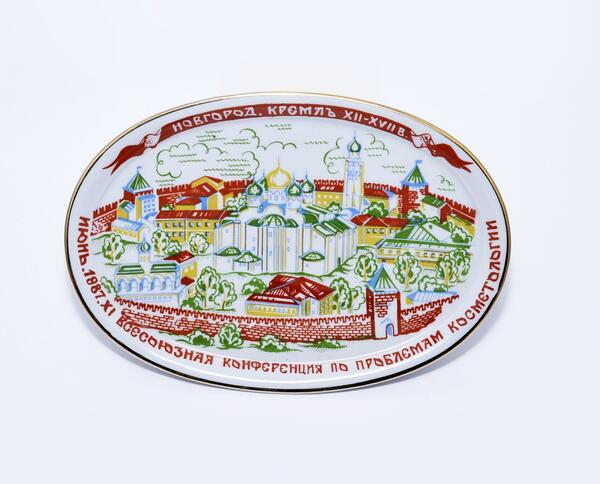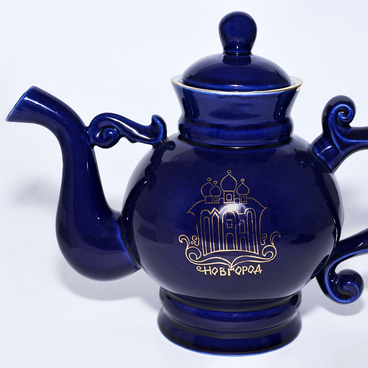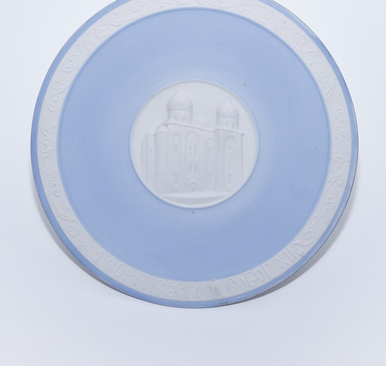The decorative plate with the image of the Novgorod Kremlin was made in 1987 at the Proletary porcelain factory. It was intended for the participants of the All-Union Conference on cosmetology, which was held in Veliky Novgorod.
Masters of the factory put the image on a plate in the technique of decal with the print transferred to the porcelain surface under high temperature. This way, the pigment was “fused” into the dishes, and thus the colors were durable, and the patterns did not fade or crack. The decal technique was actively used at the Proletary factory in the 1980s.
Because of thermal effects, some colors could slightly change, so the palette of colors for hot decal was limited. For the plate from the museum’s collection, the artisans used four primary colors — green, red, blue, and yellow. The center of the image depicts the Saint Sophia Cathedral with gold and bright green domes. Behind it, on the right, is the tall clocktower. The red brick wall with three archway entrances surrounds the architectural ensemble.
Another name for the Novgorod Kremlin is Detinets, which means the central and most ancient part of ancient Russian cities. It is uncertain when exactly the Kremlin was built, but the Russian chronicles first mention it in 1044. At first, historians thought that there was nothing left of the structure. However, during the excavations, archaeologists found logs of oak, which dated back to the 11th century. Now they are considered the remains of the ancient fortress, built by the Novgorod Prince Vladimir Yaroslavovich.
The Kremlin was a defensive structure, so it was placed on the bank of the Volkhov River, and there was a deep moat surrounding the fortress from the north, west and south. The brick walls are 1,487 metres in circumference, being from 3.6 to 6.5 meters thick, with their height varying from 8 to 15 meters. In the 15th century, the fortress had twelve towers, but only nine of them have survived to this day — Dvortsovaya, Spasskaya, Knyazhaya, Kokui, Pokrovskaya, Zlatoust, Metropolitan, Fedorovskaya, and Vladimirskaya.
The Detinets comprises the main architectural monuments of the city, which were built in different centuries. For example, it houses the oldest temple in Russia — the Saint Sophia Cathedral (1045–1050), as well as the oldest public building — the Episcopal Chamber or Chamber of Facets (1433), and other buildings of the 15th — 19th centuries.
Masters of the factory put the image on a plate in the technique of decal with the print transferred to the porcelain surface under high temperature. This way, the pigment was “fused” into the dishes, and thus the colors were durable, and the patterns did not fade or crack. The decal technique was actively used at the Proletary factory in the 1980s.
Because of thermal effects, some colors could slightly change, so the palette of colors for hot decal was limited. For the plate from the museum’s collection, the artisans used four primary colors — green, red, blue, and yellow. The center of the image depicts the Saint Sophia Cathedral with gold and bright green domes. Behind it, on the right, is the tall clocktower. The red brick wall with three archway entrances surrounds the architectural ensemble.
Another name for the Novgorod Kremlin is Detinets, which means the central and most ancient part of ancient Russian cities. It is uncertain when exactly the Kremlin was built, but the Russian chronicles first mention it in 1044. At first, historians thought that there was nothing left of the structure. However, during the excavations, archaeologists found logs of oak, which dated back to the 11th century. Now they are considered the remains of the ancient fortress, built by the Novgorod Prince Vladimir Yaroslavovich.
The Kremlin was a defensive structure, so it was placed on the bank of the Volkhov River, and there was a deep moat surrounding the fortress from the north, west and south. The brick walls are 1,487 metres in circumference, being from 3.6 to 6.5 meters thick, with their height varying from 8 to 15 meters. In the 15th century, the fortress had twelve towers, but only nine of them have survived to this day — Dvortsovaya, Spasskaya, Knyazhaya, Kokui, Pokrovskaya, Zlatoust, Metropolitan, Fedorovskaya, and Vladimirskaya.
The Detinets comprises the main architectural monuments of the city, which were built in different centuries. For example, it houses the oldest temple in Russia — the Saint Sophia Cathedral (1045–1050), as well as the oldest public building — the Episcopal Chamber or Chamber of Facets (1433), and other buildings of the 15th — 19th centuries.



